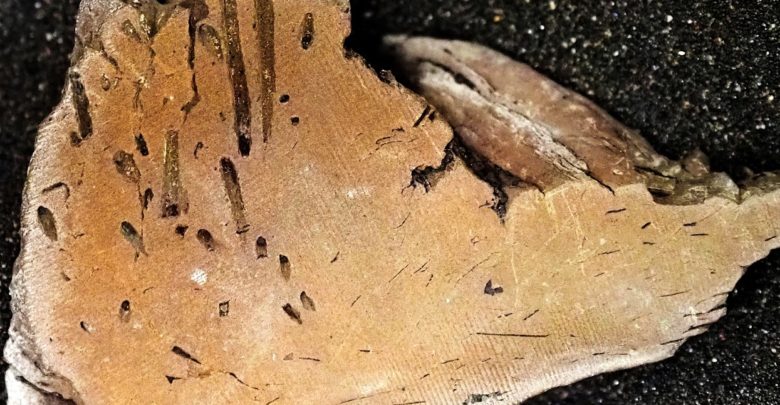 Scott Melnyk
Scott MelnykA University of Alberta graduate student identified a new species of marine organisms through the discovery of a trace fossil considered to be only the third of its kind in the current fossil record.
Scott Melnyk, a second-year earth and atmospheric sciences PhD student, made quite the discovery when the unique markings on a piece of fossilized wood caught his attention. Melnyk identified the markings to be those of burrowing tracks left behind by a previously unidentified marine animal that potentially resembled those of modern isopod species.
The fossil, named Apectoichnus lignummasticans by Melnyk and his supervisor, which translates roughly to “wood-chew,” is a gateway to the past. From a single fossil, Melnyk was able to infer the food-seeking behaviours, habitat preferences and evasive strategies of the animal.
While completing his PhD, Melnyk is currently conducting his research as a member of the Ichnology Research Group under the supervision of Murray Gingras, an earth and atmospheric sciences professor. Ichnology is a branch of paleontology that utilizes the study of trace fossils to, as Melnyk states, “solve different geological, sedimentological, or paleontological problems to better understand different aspects of the Earth through geologic time.”
These trace fossils, unlike body fossils, do not preserve the organism itself, but rather, document the lives they lived. From the impressions of footprints or fossils of preserved burrows, ichnologists can infer the lifestyles of animals in relation to their environment as well as further their understanding of Earth’s early geological conditions.
“What makes them useful is that they provide insight into what the animal was doing while it was alive so in a sense they are windows into past animal behaviour,” Melnyk stated.
The fossil Melnyk was researching belonged to a large collection of drill cores — small, cylindrical sections of the Earth excavated for exploration and research purposes — donated to the university by Shell Canada. The fossil had remained in storage, undiscovered for years, until he came across it.
The discovery was unexpected, but a welcome surprise for Melnyk, nonetheless.
“To be honest, when I first saw the trace fossil I didn’t know how unique it really was,” Melnyk said. “I knew there was something weird about it but when we finally figured out what it was, it was pretty exciting.”
Melnyk says the discovery of the fossil helped to further expand the currently limited fossil record pertaining to species of marine wood-boring organisms.
‘‘Fossils are inherently rare, but in terms of the fossil record they’re not too uncommon,” Melnyk informed. “The burrowings that are made by land animals are much more diverse than the ones that we see for marine animals, so the new trace fossil is unique because it’s only the third type of wood-boring trace fossil that was made by a marine animal.”
It was also an especially remarkable find due to its contributions to the understanding of early Canadian geology.
“The fossil material that we found was a piece of wood that is over a hundred million years old and the fossilized burrowings that are in it are similar to those that we see on todays’ coasts,” said Melnyk. “Because of that, the fossils that we found are evidence that a hundred million years ago the sea level was much higher than today and there was a coastal environment on the western edge of Saskatchewan.”
With this impressive accomplishment to his name, Melnyk hopes to continue pursuing his passion for ichnology.
“I don’t really have a concrete plan because it’s definitely hard to pinpoint something or bank on something but for now, I just want to continue my research and keep learning about applied ichnology.”




